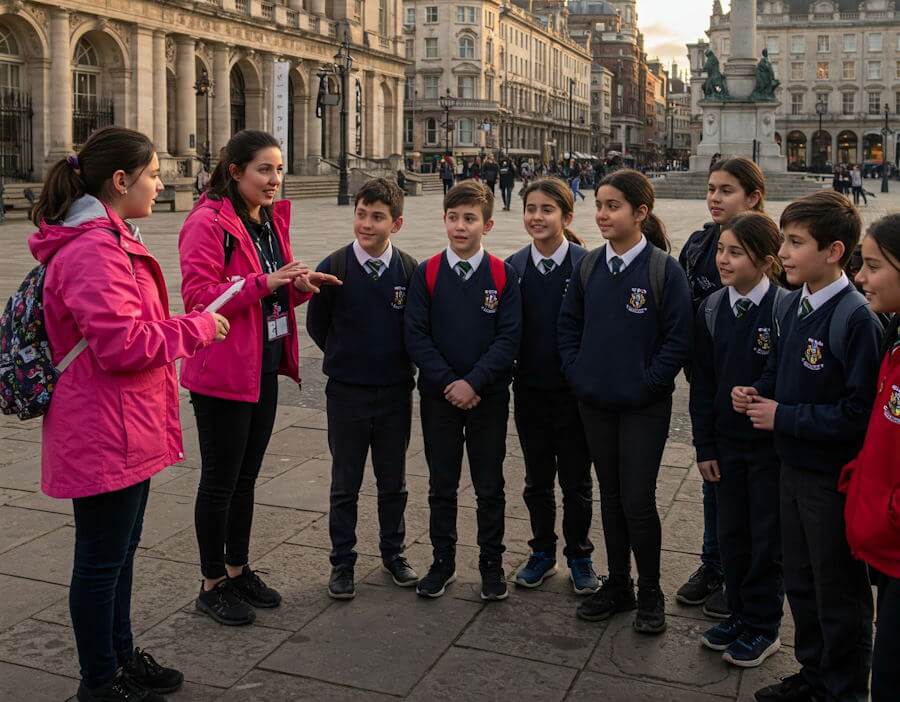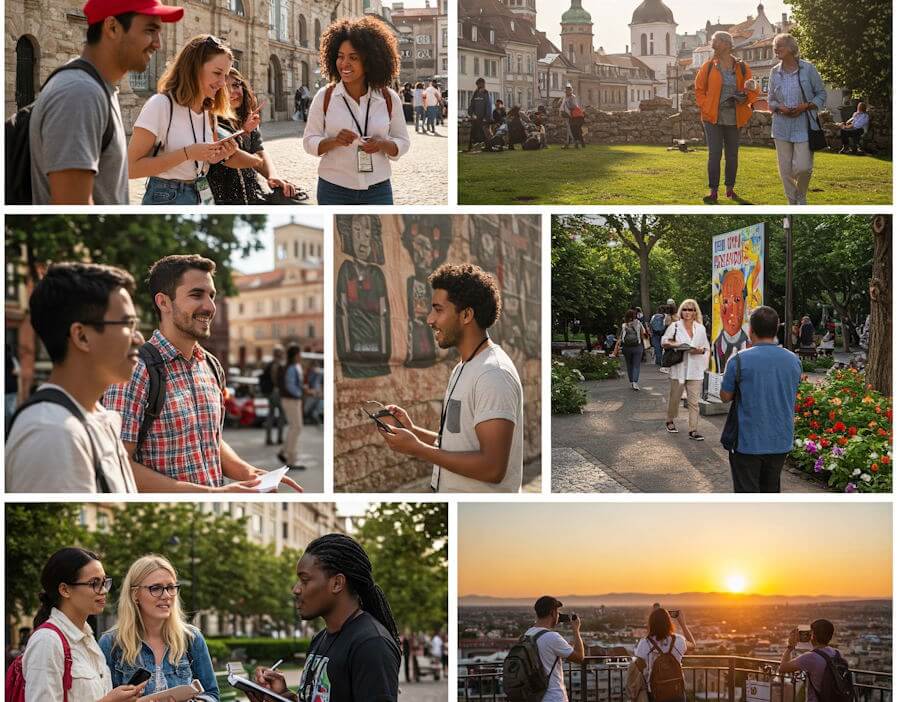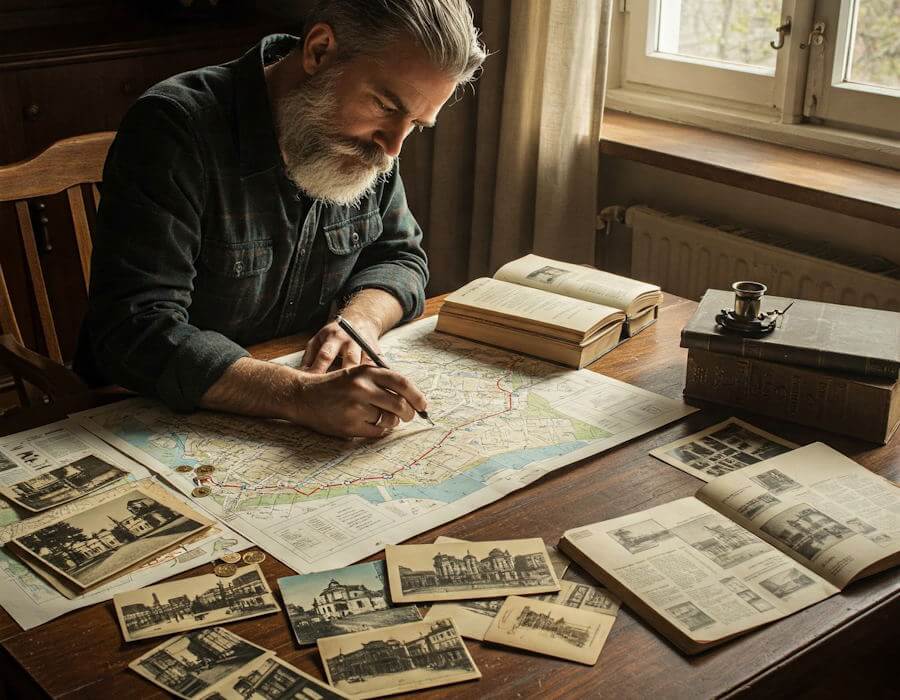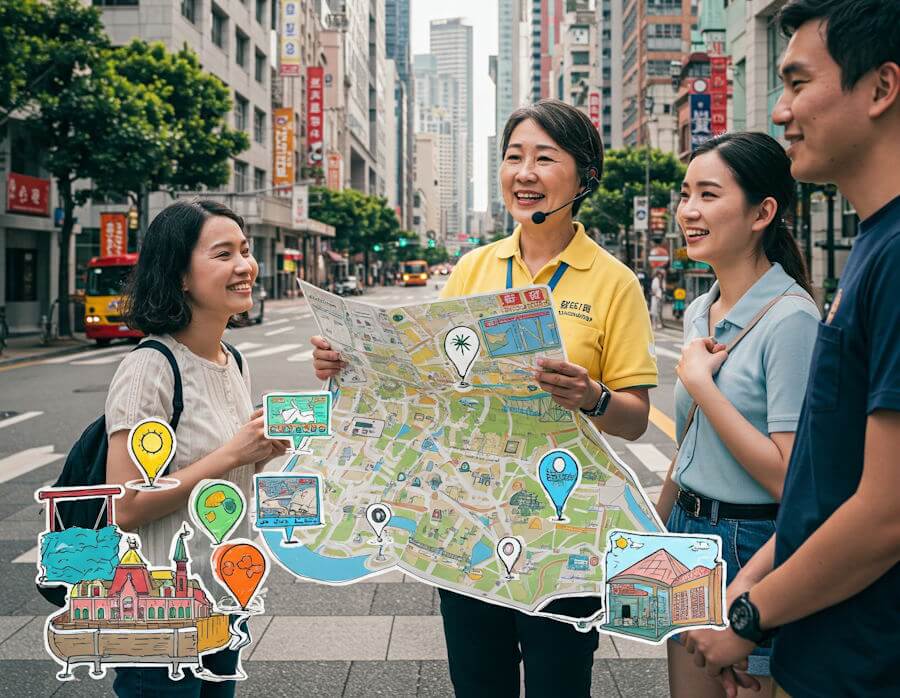Introduction to Educational City Tours
The concept of educational city tours tailored for students and schools has gained significant traction in recent years, reflecting the evolving landscape of experiential learning. These tours provide an invaluable opportunity for students to step beyond the confines of the traditional classroom and engage with their surroundings in a meaningful way. Experiential learning, as facilitated by city tours, enhances educational outcomes and fosters deeper retention of knowledge through real-world application.
City tours designed for educational purposes are structured to complement the school curriculum while simultaneously igniting students’ curiosity about their cultural and historical heritage. By incorporating visits to significant landmarks, museums, and community centers, students not only gain firsthand insight into various subjects but also develop a greater appreciation for their community’s diverse history and social fabric. Such immersive experiences cultivate critical thinking and problem-solving skills, as students engage with their environment in ways that textbooks alone cannot impart.
Furthermore, educational city tours are instrumental in promoting the development of social skills among students. As they interact with peers and tour guides, students learn the importance of collaboration, communication, and respect for diversity. These tours encourage teamwork and involvement, serving to break down social barriers and fostering inclusivity. Through guided interactions in varied cultural settings, students can develop empathy and cultural understanding, key components of global citizenship in today’s interconnected world.
In summary, educational city tours present a multifaceted approach to learning that extends beyond traditional classroom methods. By immersing students in hands-on experiences, schools can not only enhance educational outcomes but also prepare students to navigate an increasingly complex and diverse society.
Identifying Learning Objectives
When designing engaging city tours for schools and students, the identification of clear learning objectives is paramount. This foundational step ensures that the tour is not only educational but also relevant to the curriculum and the students’ learning experiences. Effective learning objectives should align with the educational standards set forth by the curriculum while simultaneously addressing the specific subject matter being explored during the tour.
Firstly, it is crucial to assess the curriculum goals. For instance, if the tour is centered on local history, the objectives could include understanding key historical events and their impact on the community. Alternatively, for a tour focused on environmental science, the goals may encompass exploring local ecosystems and promoting stewardship. Clearly defined objectives such as these create a framework that guides the content and activities during the tour, ensuring they remain focused and impactful.
In addition to aligning objectives with the curriculum, it is essential to consider the relevance of the subject matter to the students. Tours should not only be informative but also captivate the students’ interests. Incorporating themes that resonate with the age group—such as interactive elements, local legends, or contemporary issues—fosters engagement and inspires curiosity. This approach not only enhances learning but also encourages students to actively participate and inquire further about the topics covered.
Moreover, selecting learning objectives that inspire curiosity is vital. Curiosity acts as a fundamental pillar in the learning process, driving students to absorb information actively rather than passively. By framing objectives that challenge students to ask questions and seek answers, educators can cultivate a more enriching educational experience. Not only does this approach facilitate better retention of information, but it also nurtures critical thinking skills that are essential for lifelong learning.
Choosing the Right Locations
When designing city tours tailored for schools and students, selecting the right locations is paramount. The ideal sites not only need to align with educational goals but should also engage students in a meaningful way. A successful approach begins with thorough research into potential locations, taking into consideration their historical, cultural, and scientific significance. This ensures that each stop on the tour adds value to the learning experience, allowing students to connect theoretical knowledge with real-world contexts.
Historical landmarks, for example, can provide students with insights into the past that resonate deeply with their curriculum. Sites such as museums, historic buildings, and monuments foster a sense of appreciation for local history, enhancing their understanding of the events that shaped their community. Cultural institutions, like galleries and theaters, expose students to the arts and diverse perspectives, promoting cultural literacy and encouraging creativity.
In addition to significance, the practicality of accessibility plays a crucial role in location selection. Ensuring that sites are easily reachable by bus or public transportation is essential for maintaining a smooth itinerary. Accessibility also extends to the physical environment; locations must be safe and accommodating for students, especially those with special needs. Safety protocols and appropriate supervision are necessary considerations, requiring a detailed assessment of each site before finalizing the tour plan.
Moreover, it is beneficial to incorporate interactive elements, such as guided tours, hands-on activities, or educational workshops at selected locations. These interactive experiences can enhance engagement and retention of information, making each visit more memorable. By diligently researching and carefully evaluating historical, cultural, and practical factors, educators can craft enriching city tours that captivate students and meet learning objectives effectively.
Integrating Interactive Elements
Incorporating interactive elements into city tours designed for schools and students significantly enhances the overall learning experience. These interactive features serve not only to engage students but also to deepen their understanding of the surrounding environment. One effective method of fostering this engagement is through the implementation of scavenger hunts. By challenging students to locate specific landmarks or artifacts, they become active participants in their learning journey. This approach not only encourages teamwork but also fosters problem-solving skills as students navigate their surroundings.
Guided discussions are another powerful tool when integrating interactive components into city tours. These discussions provide opportunities for students to express their thoughts and ask questions, promoting a dynamic exchange of ideas. As students explore various sites, having knowledgeable guides facilitates discussions that stimulate critical thinking. By connecting historical and cultural narratives to the places visited, students can gain a more holistic understanding of the city’s significance. Moreover, the infusion of real-time questions and answers helps maintain their interest and enthusiasm throughout the tour.
Hands-on activities, such as crafting or role-playing historical events, also play a crucial role in enhancing the educational value of city tours. These activities allow students to experience history and culture in a tangible manner, reinforcing their learning through practical engagement. For instance, a role-playing exercise at a historic site can bring past events alive, allowing students to better comprehend the context and importance of what they are observing. Such immersive experiences create lasting memories and make the tour not just a series of observations, but an educational journey that resonates with students long after the tour concludes.
Considering Different Learning Styles
When designing city tours for schools and students, it is essential to acknowledge the various learning styles present within a group. Understanding these differences allows educators and tour organizers to create an inclusive experience that resonates with all participants. Primarily, learners can be classified into three categories: visual, auditory, and kinesthetic. Each group processes information in unique ways, and accommodating these styles ensures that every student can benefit from the tour.
For visual learners, incorporating exhibits that are rich in imagery and design can significantly enhance their experience. Visual aids, such as maps, infographics, and diagrammatic representations, can be employed to provide context and visual stimulation. Additionally, the use of videos or photographs during the tour can help reinforce learning by presenting information in an engaging manner. To further captivate visual learners, the tour can include opportunities to interact with artistic displays or historical landmarks, allowing them to visualize concepts more effectively.
Auditory learners, on the other hand, thrive on verbal communication and storytelling. Guided narration, whether through a professional guide or pre-recorded audio, plays a pivotal role in their understanding of the material being presented. Engaging these learners can include utilizing questions and discussions throughout the tour. Organizers might also consider integrating music or dramatic readings that relate to the sites visited, creating a multi-sensory environment conducive to deeper engagement with the subject matter.
Lastly, kinesthetic learners benefit from hands-on experiences. To cater to them, the tour could feature interactive elements such as workshops, physical challenges, or role-playing activities relating to the historical events associated with the sites visited. By allowing students to participate actively, they can form connections to what they are learning through movement and tactile engagement. Ultimately, designing city tours that consider these diverse learning styles not only maximizes educational outcomes but also ensures that every student finds value in the experience.
Planning Logistics and Safety
When organizing city tours for schools and students, meticulous planning of logistics and safety measures is essential. A primary consideration is transportation. Depending on the size of the group, schools can opt for buses, public transit, or even walking tours. Each mode of transportation has its pros and cons, including cost, convenience, and safety. For example, using school buses can provide a direct and safe means of transport; however, it may also require additional planning regarding schedules and availability. Public transit may offer more flexibility but can pose challenges regarding supervision and safety.
Timing is another critical factor to consider. A well-planned itinerary should allow sufficient time for each activity, taking into account travel times and breaks. It is advisable to conduct site visits ahead of the tour to familiarize oneself with time requirements and potential delays. Additionally, planning for contingencies, such as inclement weather or unexpected events, can help ensure a successful outing.
Group size plays a crucial role in safety and engagement. Smaller groups tend to be more manageable and allow for greater interaction among participants. Ideally, the number of adults should be sufficient to maintain a safe adult-to-student ratio, often recommended to be one adult for every ten students, depending on age and activity level. This ratio enables effective supervision and fosters a secure environment.
Safety measures cannot be overlooked in the planning process. Schools should develop a comprehensive safety plan that includes emergency contacts, a first aid kit, and procedures for handling various incidents. Communicating expectations and conduct guidelines to students prior to the tour will also help to promote a safe and respectful atmosphere. Collaborating with local authorities or tour operators can provide additional support and resources for a safer experience. Overall, thorough planning of logistics and safety contributes significantly to the success of city tours for students.
Post-Tour Activities and Reflections
Engaging students in post-tour activities is crucial for reinforcing the learning experiences gained during a city tour. Reflection promotes critical thinking and helps students process their observations and insights. Various activities can be designed to facilitate this reflective process, encouraging learners to articulate their understanding in meaningful ways.
One effective approach is organizing group discussions, where students can share their thoughts and feelings about the tour. These discussions can lead to a deeper exploration of the topics covered, as students relate their personal experiences to the broader themes of the city and its culture. Facilitators can guide these discussions by posing open-ended questions that prompt students to consider what surprised them or what they found particularly impactful.
In addition to discussions, creative projects can serve as a powerful tool for reflection. Students may create visual artworks or multimedia presentations that depict their experiences and learnings. This not only encourages creativity but also allows them to express their perspectives in diverse ways. Collaborative projects enhance teamwork and can culminate in a presentation where students showcase their work to their peers, thereby reinforcing their learning and building confidence.
Writing assignments also play a significant role in post-tour reflection. Students can compose essays, journals, or letters that articulate their personal reflections and summarise key takeaways from the tour. This type of exercise not only improves writing skills but also solidifies their understanding of the material covered during the city tour. By reflecting on their experiences through writing, students gain an opportunity to think critically about how the tour’s content relates to their lives and educational journey.
In conclusion, post-tour activities such as discussions, creative projects, and writing assignments are instrumental in helping students process and internalize their learning outcomes. These reflective practices enhance the overall educational value of city tours and contribute to a more enriching experience for students.
Gathering Feedback and Continuous Improvement
Feedback from students and educators is a crucial element in the success of any city tour designed for educational purposes. It serves as a key indicator of what aspects resonated well with participants and which areas need refinement. By systematically collecting and analyzing this feedback, tour organizers can enhance the educational value of their offerings. Various methods can be employed to gather input effectively, ensuring a comprehensive understanding of the participants’ perspectives.
One common method for collecting feedback is through post-tour surveys. These surveys can be designed with a combination of quantitative and qualitative questions, allowing students and educators to rate their experiences and provide detailed comments. Digital platforms can facilitate easy and timely distribution of these surveys, ensuring that participants can engage with the process shortly after completing the tour when their impressions are still fresh. Furthermore, some tours may benefit from conducting focus groups, where participants can engage in open discussions about their experiences. This method encourages deeper insights into specific areas of the tour, such as content delivery, logistics, and overall enjoyment.
Another effective avenue for gathering feedback is through social media interactions. Encouraging students to share their thoughts and reflections on their experiences via social media platforms can not only provide valuable insights but also promote the tour to a wider audience. Additionally, collaboration with educators can bring forth suggestions based on classroom contexts, enhancing the relevance of the tour content to the curriculum.
Once this feedback is collected, it can be systematically analyzed to identify patterns and trends. This analysis can reveal strengths to build upon and weaknesses to address, making it a cornerstone for continuous improvement. By utilizing this information, tour organizers can make informed adjustments to tour designs, thus enhancing overall educational value and ensuring that future tours meet the evolving needs of students and educators.
Case Studies of Successful City Tours
City tours have emerged as a dynamic educational tool for schools, offering students an immersive learning experience that extends beyond the traditional classroom setting. Various successful implementations of such tours showcase different approaches and strategies, serving as exemplary models for other educational institutions.
One notable case study involves a partnership between a local history museum and a high school in an urban area. This collaboration resulted in a guided city tour that explored significant historical landmarks. Educators developed a thematic framework, aligning the tour’s focus with the curriculum on local history. The outcomes were reported as highly positive, with 85% of participating students expressing a greater understanding of their city’s heritage. Testimonials from both teachers and students highlighted the engaging nature of the tour, emphasizing how the real-world connections made learning more tangible and relatable.
Another successful example can be found in an elementary school that organized a nature and sustainability-themed city tour. This tour included visits to community gardens and sustainability projects around the city. Teachers designed interactive activities, enabling students to participate actively in discussions about environmental stewardship. Post-tour evaluations indicated that over 90% of students felt inspired to engage in sustainable practices, demonstrating the impact that experiential learning can have on young minds. Feedback from educators praised the tour for fostering a sense of community responsibility among students.
Additionally, a university collaborated with local businesses to create a career exploration city tour. This initiative was aimed at high school students contemplating future career paths. Participating organizations opened their doors for tours, allowing students to engage with professionals and gain insights into various industries. The success of this endeavor was reflected in increased applications to vocational programs, illustrating the effective alignment of practical experiences with student aspirations. Reflected testimonials revealed an eagerness among students to explore diverse career options.
These case studies exemplify the diverse strategies that can be employed in designing engaging city tours, showcasing how schools can enhance learning through real-world experiences.




